Officine Panerai unveiled two completely new Special Editions at this year’s SIHH 2017 (Salon International de la Haute Horlogerie) in Geneva. This was not an official launch. The PAM00720 and PAM00721 were shown to select customers only. According to the document below, both watches are supposed to be released later during the year.

.
Photos of these watches mysteriously appeared on Instagram and disappeared within 24 hours, creating quite a buzz. More photographs surfaced later on different watch forums.
One of the two new models, the PAM00721 (picture below), really surprised me. With its “anonymous” dial it is clearly an homage to the typical “Panerai” watches used by Nazi Kampfschwimmer (Combat swimmers) commandos during WW2.

.
Nazi Kampfschwimmer units were deployed from summer 1944 onwards to slow down the Allied advancing, closing in from east and west towards Berlin. Their main purpose was to sabotage and destroy bridges.
The watch pictured below is a 3646 Type D “Kampfschwimmer” with “anonymous” dial, basically the original watch the PAM 721 is based upon.

.
Some of these watches have distinctive engravings on their casebacks, leaving no doubt of their true provenance as Nazi Kampfschwimmer equipment. These engravings were made during the captivity of the German frogmen unit on the island of Sylt in northern Germany. The font is clearly inspired by the Fraktur, a font that was considered “Urdeutsch” (true German script) by the Nazis. Ironically, in January 1941 the Fraktur font was declared to be “Judenlettern” (Jewish letters) and prohibited.

.
Officine Panerai has a very similar watch in their Archivio Storico Panerai (Panerai Museum). The watch below was exhibited at the SIHH 2017 in Geneva as inspiration for the PAM 721. An interesting observation is that the specified date, 1936, is completely wrong. This type of watches were supplied in 1944.
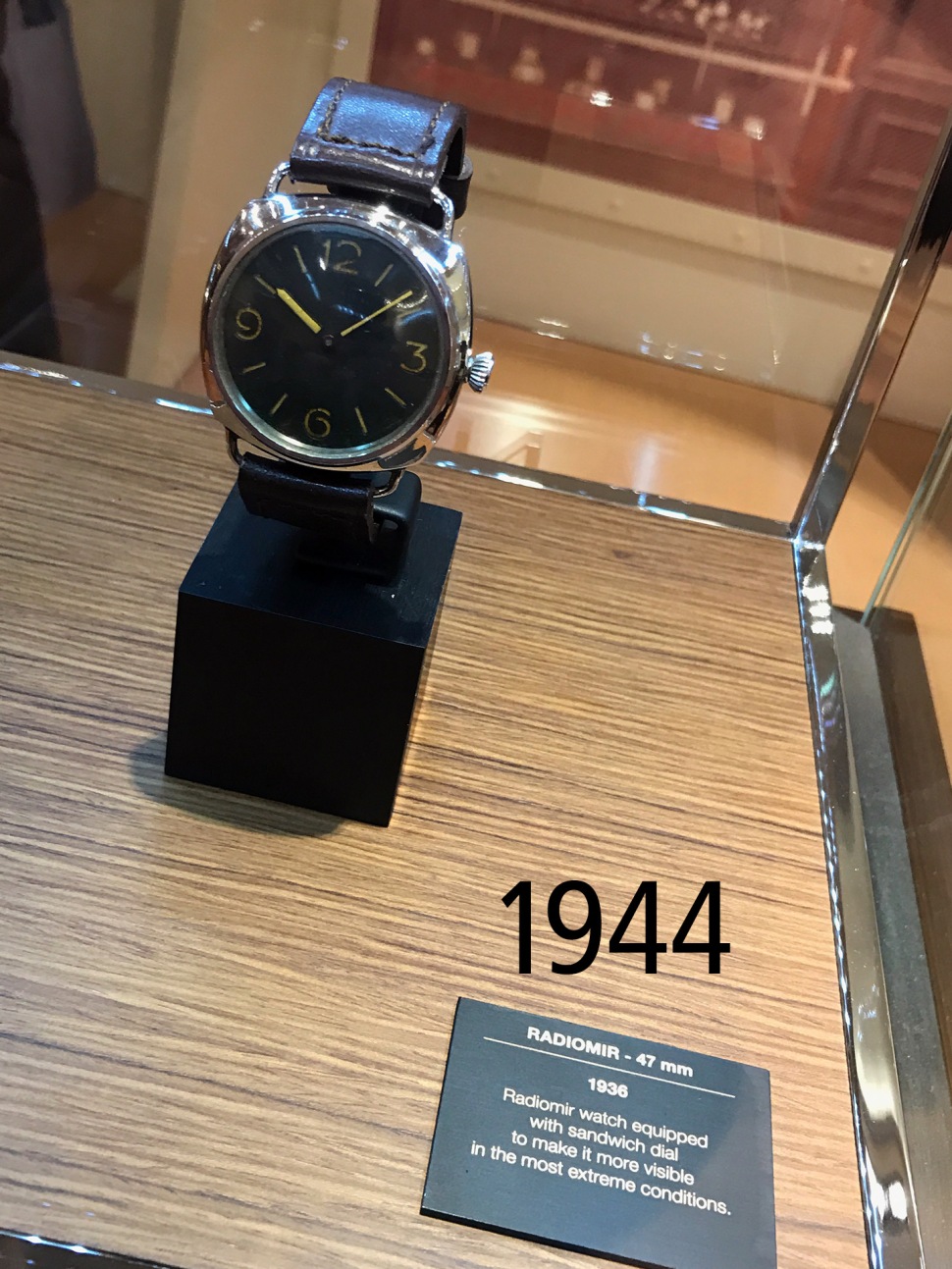
.
However, the very same watch was also on display at the “Dive Into Time” exhibition in Florence in May 2016. As you can see, back then the date on the plaque was 1938.
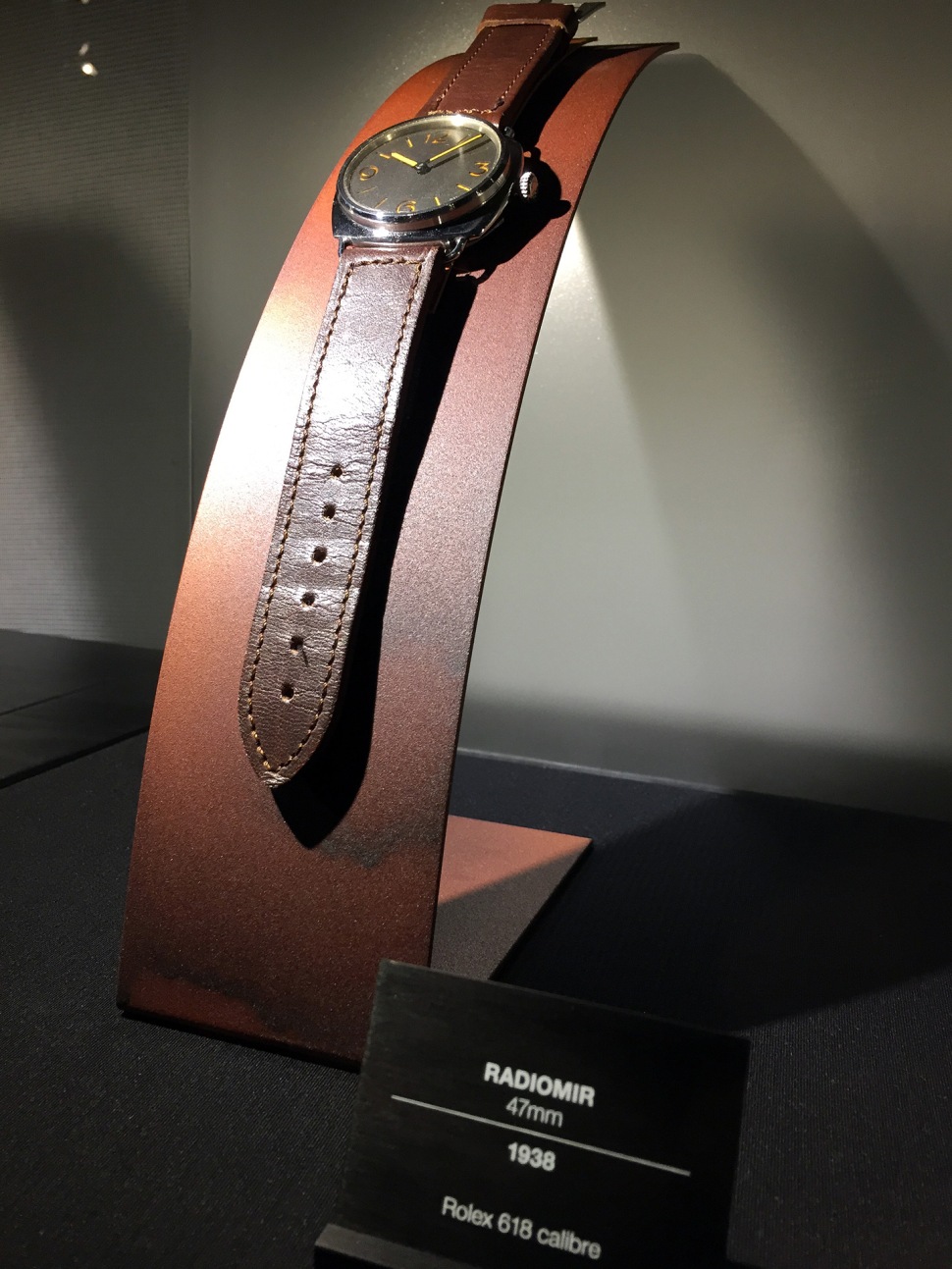
.
Officine Panerai showed three more vintage “Panerai” watches at the SIHH 2017. A 3646 “Kampfschwimmer” with California dial from 1944 was described as the first prototype from 1936. A 6152 from 1953 all of a sudden was made in the 1940s and a 6152/1 with Angelus 240 made in the 1960s was misdated as from the 1950s.
.
Nazi Kampfschwimmers
Starting in January 1944, Nazi Kampfschwimmer recruits received their training from experienced Italian Decima MAS frogmen in Italy.
The Decima MAS unit had pioneered new techniques of underwater sabotage warfare with manned topedoes (SLC, Maiale) and assault swimmers. The need of this unit for reliable water resistant watches gave birth to the famous “Panerai” watches, which were developed and produced by Rolex.

.
Recent Panerai related literature has romanticised the German frogmen by taking their formation in Italy totally out of the historic context and portaying them as partners of the Italians. When the Kampfschwimmers started their training at the facilities of the Decima MAS, Italy was no longer an ally to Nazi Germany.
To get the full picture of what really happened during this period of the war and to understand how hundreds of “Panerai” watches ended up on the wrists of Nazi forces, we need dive deep into the events following the Italian surrender to the Allies on September 8, 1943. After doing so, it appears highly unlikely that G. Panerai e Figlio supplied the original “Kampfschwimmer” watches voluntarily to the Nazis and it becomes more and more clear that Giuseppe Panerai may not have been very proud of this chapter in his company’s history.
.
The occupation of Italy
Benito Mussolini, the megalomaniac fascist dictator of Italy with imperial ambitions to restore the Roman Empire in the “Mare Nostrum” (Latin for Our Sea, the Mediterranean) forced his country into an alliance with Nazi Germany. After his “March on Rome” in October 1922, Mussolini built a totalitarian state with himself as the supreme leader. Mussolini was, in many ways, Hitler’s mentor.

.
Italy entered the Second World War as part of the Axis powers (Rome-Berlin-Tokyo) in June 1940. Soon it became very clear that Italy could not keep up with its ally Nazi Germany in terms of successful warfare. Mussolini was deeply humiliated after his embarrassing attempt to conquer Greece and the need to be “rescued” by Nazi Germany.
In July 1943, the Allies landed successfully in Sicily in order to divert Nazi forces from the Russian front by opening a secondary front in southern Europe.

.
After the eternal city of Rome, with all its amazing artwork and irreplaceable historic architecture, had become a target of massive Allied bombings causing over 3.000 dead and 11.000 injured, on July 19, 1943, the Italians grew weary of the war.

.
In a last-ditch effort to prevent further destruction and to extricate Italy from the war, the fascist grand counsel voted to remove Mussolini from power and dismantle his dictatorship and the fascist party. Benito Mussolini was arrested on July 24, 1943. Hitler was furious when he heard of Mussolini’s fate.
Mussolini’s imprisonment and the end of the fascist party sparked new hopes among the population. After 3 years of war, the Italians went to the streets to celebrate the end of the conflict. The real tragedy however, was only about to begin.

.
The Nazis knew that Mussolini’s position had weakened and were already prepared for his loss of power. Immediately after Mussolini’s fall, two German divisions entered Italy. The official Italian government under King Victor Emmanual the 3rd continued to claim allegiance to Nazi Germany but secret negotiations with the Allies had already taken place in order to extricate Italy from the war.
Well aware of a possible defection, the German troops reinforced their presence in Italy. The number of divisions was increased from two to seven and crucial infrastructure was put under German control.
As expected, the new Italian government surrendered to the Allies. The Armistice of Cassibile (ceasefire) between Italy and the Allies was made public on September 8, 1943.
Italy was absolutely vital for the successful defense of Germany. In “Operation Achse” the German troops immediately attacked and disarmed Italian forces and occupied large parts of the country. The majority of the Italian armed forces had not been informed about the Armistice. Without specific orders, they literally desintegrated within days.
Italian soldiers were given the choice to keep fighting on the side of the Axis, or be disarmed and deported to Germany for slave labour. It is worth noting that around 710.000 Italian soldiers ended up in Nazi concentration camps on German soil. German companies like Mercedes, Volkswagen, Bosch, etc. used slave labour from conquered lands and became extremely wealthy in this process.
However, a vast number of Italian men were killed simply because they refused to surrender their guns.

.
King Victor Emmanual the 3rd, along with his family and his new head of state Marshal Pietro Badoglio fled Rome on September 9, 1943. New headquarters were established in Brindisi, in southern Italy.
The Italian Navy High Command ordered Italian warships, mostly located in La Spezia and Genoa, to sail for North Africa and join the Allied forces. Enraged by this defection, the German troops summarily executed several Italian captains who, unable to leave the harbours in time, had destroyed their vessels. The very same day, on September 9, 1943, German bombers attacked the ships off Sardinia with guided bombs. Several vessels suffered damage. The battleship “Roma” sank and 1.400 sailors lost their lifes.

.
Mussolini, who had been held captive at a secret location on the mountain of Gran Sasso, was rescued by Nazi elite forces in a spectacular operation named “Operation Eiche” on personal orders of Adolf Hitler. Mussolini was sent to Berlin to meet with Hitler in the Führerhauptquartier (Headquarters). The German dictator ordered Mussolini to go back to Italy and build a new fascist government in order to regain control over Italy. Under German lead, Mussolini was reinstalled as dictator of a puppet regime named “Republica Sociale Italiana” (Italian Social Republic).

.
Soon after, in October 1943, the Kingdom of Italy officially declared war on Nazi Germany.
The Nazis were brutal and left no doubt about who was in charge. Italians who were caught with arms were executed on the spot. Every act of sabotage was met with severe consequences.
On the Greek island of Cephalonia, soldiers of the Italian Acqui Division embraced the news of the Armistice. They assumed the war was over and the time had finally come to go back to their families. But the joy was of short duration. Soon German troops approached the Acqui Division and ordered the immediate surrender of all arms. Like any other Italian soldiers, the Acqui Division received the choice to keep fighting with the Germans, or be deported to Germany for slave labour.
The commander of the Acqui Division, General Antonio Gandin, was known to be pro-German. Gandin was apparently sent to Cephalonia for this very reason. The King and his head of state, Marshal Pietro Badoglio, feared Gandin could interfere in their plans to surrender to the Allies.
However, the Italian High Command in Brindisi gave orders to resist any attempt to be disarmed by the Germans. Gandin tried to negotiate with the German side, but due to growing anti-German sentiments among officers and soldiers, the decision was made to restist the German forces. In the following inevitable battle, more than 1200 Italians lost their lives. Thanks to complete German air superiority the Nazis soon gained the upper hand. At this point, Hitler personally gave the order that no prisoners are to be taken. On September 22, 1943 the Italians ran out of ammunition and had to surrender.
The German troops executed 5155 Italian soldiers and officers, including General Gandin, during the following days. The bodies were scattered all over. At some point the killing was suspended and the rest of the Italian prisoners were forced to board two ships to be transported to POW (Prisoner of War) camps in Germany. Once out in the sea, the ships were destroyed by the Germans and more then 3000 Italians drowned. This was a way more effective way to get rid of the prisoners. The “Massacre of the Acqui Division” stands as one of the worst single crimes commited by the German Wehrmacht.

.
The Nazis commited a series of massacres against the Italian population in the months that followed. Entire villages were wiped out in reprisal of local support given to Italian partisans and the resistance.
The massacres of Marzabotto (770 dead) and Sant’ Anna di Stazzema (560 dead) stand testament to the merciless execution of women, children and men. 335 Italian prisoners were executed near Rome in retaliation for the death of 33 Nazi SS policemen, who had been killed by Italian partisans. Essenatially, each German was worth 10 Italians…

.
The Italian people became hostages in their own country and suffered tremendously under the Nazi tyranny. As a matter of fact, not a single jew had ever been deported from Italy before July 1943. In October 1943, the Nazis raided the Jewish Ghetto in Rome. In November 1943, the Jews of Genoa and Florence were rounded up and deported to Auschwitz. It is estimated 7,500 Italian Jews became victims of the Holocaust.
Junio Valerio Borghese, the commander of the Decima MAS, was a long-time member of the Italian unit and had participated on several successful sabotage missions as commander of the submarine “Sciré”.
Borghese’s most famous operation with the Decima MAS had certainly been the attack on Alexandria, when on December 19, 1941, three Italian SLC teams (manned torpedoes) exit the “Sciré” and managed to enter the harbour of Alexandria in Egyp. Two important British battleships, the “HMS Queen Elizabeth” and “HMS Valiant”, along with the large tanker “Sagona” were damaged and disabled for months. Altough all six crewmen: Luigi Durand de la Penne and Emilio Bianchi, Antonio Marceglia and Spartaco Schergat, Vincenzo Martellotta and Mario Marino, were captured by the British, the mission temporarily changed the balance of power in the Mediterranean Sea. The British were left in awe: “All of us thought the Italian Navy was hopeless, inefficient, and even cowardly… However, we soon revised our opinions about their heroism and ingenuity.”
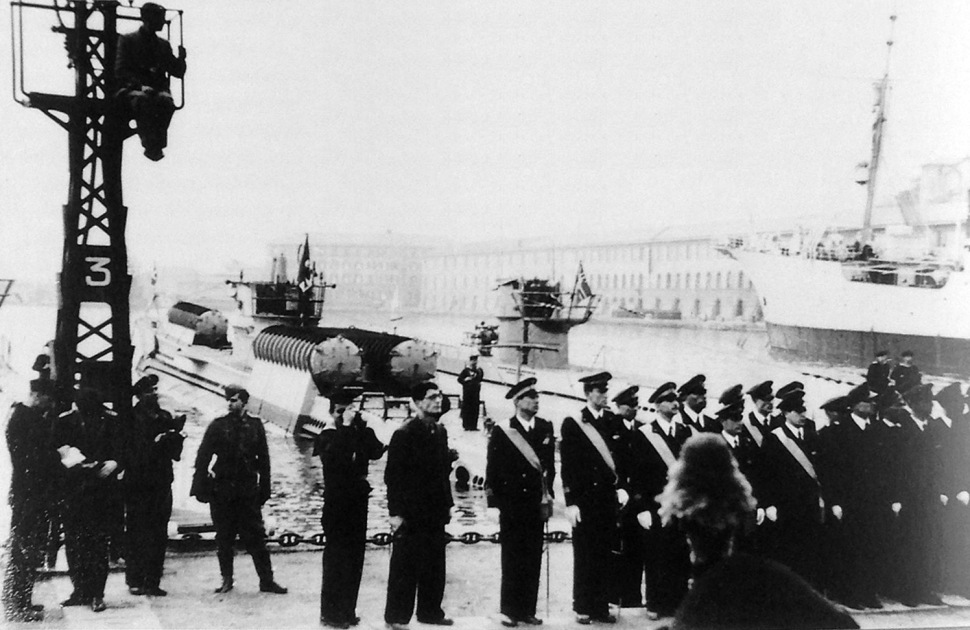
.
Borghese heard the news of the Armistice of Cassibile on September 8, 1943 on the radio. None of the Italian armed forces had previously been informed and no specific orders were given. It was total chaos.
German forces in tanks and armoured vehicles approached the fortress of Varignano, base of the Decima MAS in Le Grazie near La Spezia. The men of the Decima MAS were of high moral and ready to give their lives to stand their ground. Several Nazi attempts to enter the baracks were met with fierce resistance. Borghese ordered to remove the explosive heads of the manned torpedoes (SLC, Maiale) and to make them ready to blow up the whole place in case the Nazis would have gained the upper hand.

.
The very same day men of the Decima MAS sank three Italian submarines to avoid losing them to the Germans.
Borghese waited in vain for orders from the Italian Navy High Command for a few days. At this point he decided to remain loyal to the Axis in order to stay under arms and retain some sort of control over the situation. Borghese gave his men the choice to leave and go back to their families. Many left.
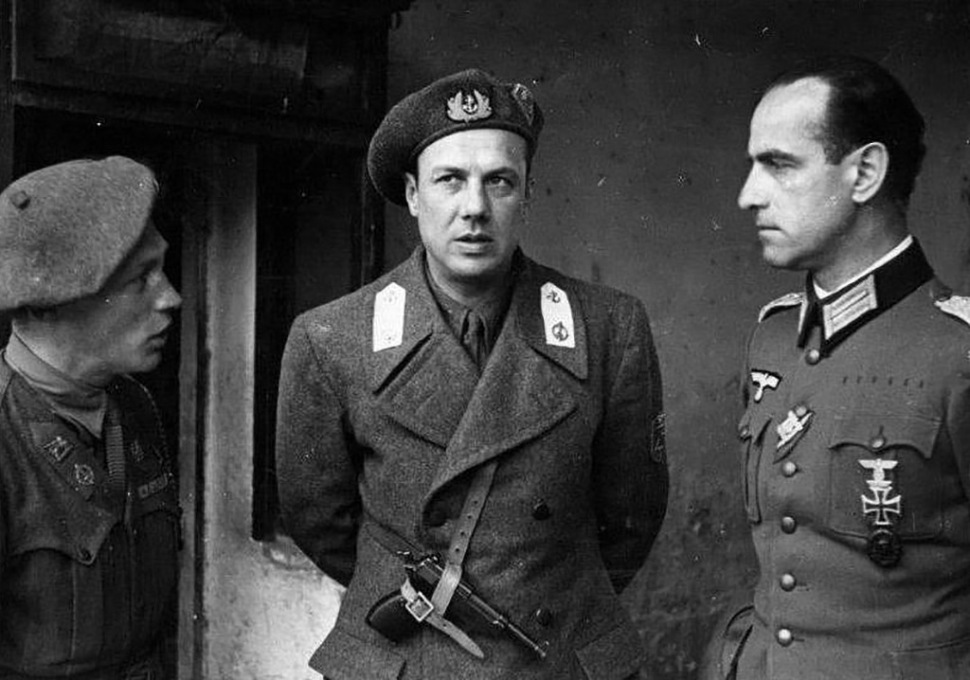
.
Borghese negotiated an agreement which gave the Decima MAS significant autonomy, allowed the unit to fight under the Italian flag (but under the command of the Nazis), and not to be employed against other Italians.
According to a famous Italian Gamma frogmen’s report, the Decima MAS was infiltrated by German officers who ended up in high ranking positions. The Decima MAS became mainly a marine infantry unit with a distinctive anti-semitic and anti-comunist ideology. The unit fought mostly on the side of the Nazis against Italian partisans and comunists.
The famous “Xa Flottiglia MAS” badge was only adopted after the Unit began to closely collaborate with the Nazis after the occupation of Italy. The original idea came from Commander Salvatore Todaro who had been killed in Tunis by an attacking British “Spitfire” aircraft in December 1942. During his final days he had expressed a desire to create a badge featuring a skull with a rose in mouth since, in his opinion, “dying in combat is a beautiful and rose-scented thing”.

.
Some sources say, the Decima MAS became Borghese’s private army, a force within the force, which helped Borghese fighting for his own ambitions rather than a government’s. Mussolini, who was afraid of Borghese’s growing power and feared a coup, ordered his imprisonment. But the Germans needed Borghese to fight Italian partisans and ordered his release.
Some members of the Decima remained loyal to the king and decided to fight on the side of the Allies. This unit was known as the “Mariassalto”. Prominent Italian combat divers in british captivity like Luigi Durand de la Penne (HMS Valiant) and Antonio Marceglia (HMS Queen Elizabeth) joined the Mariassalto unit after they were released in 1944. It is said, that the Mariassalto still maintained some sort of contact to the Decima MAS.

.
The Allies feared, the Germans would try to block the harbour of La Spezia by sinking ships in its entrance. To prevent this from happening, on June 21, 1944, the Mariassalto unit sunk the cruiser “Bolzano” and further damaged the cruiser “Gorizia”, which had already been attacked by British bombers in April 1943. The Mariassalto unit used “Chariots”, the british version of the Italian SLC (manned torpedo), to fullfil this mission. A similar mission was undertaken on April 19, 1945. Men of the Mariassalto unit used once again “Chariots” to sink the Italian aircraft carrier “Aquila” in the harbour of Genoa.
Nazi Kampfschwimmers began their training in January 1944 at the Decima MAS facilities in Valdagno, long after Italy had been occupied. The German trained separate from the Italians. For some reasons, Borghese ordered his men on several occasions to sabotage Nazi equipment.

.
The picture below shows a group of German Kampfschwimmers wearing “Panerai” watches. Please click the picture to zoom in.

.
More and more Kampfschwimmer recruits were sent to Italy. On June 11, 1944, four SS Kampfschwimmers passed the village of Borga (above Recoaro Terme) on their way back from a hiking trip. The village was packed with Italian partisans. When the armed Nazis approached, the partisans opened fire and killed one of them, SS Kampfschwimmer Herman Georges. The rest of the Nazis flew to Valdagno and alarmed the headquarters.
A Jagdkommando (Special Ops) along with members of the SS Kampfschwimmers was sent to the village for immediate retaliation. The partisans had left the village right away after the shooting. In consequence, 17 innocent men of the village – fathers and sons – were killed by the Nazis and the whole village was burned to the ground.

.
Valdagno became too dangerous for Nazi Kampfschwimmers and as a result, and also to train under real-life conditions in the sea, most of them moved to the island of San Giorgio in Alga (2) in Venice the very next day on June 12, 1943.
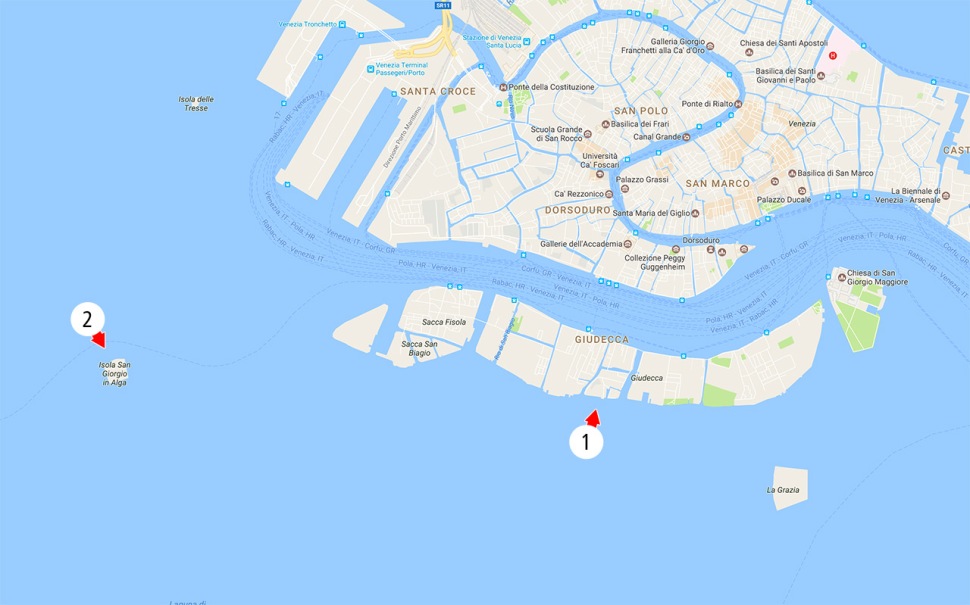
.
“Panerai” watches were supplied to Nazi Kampfschwimmers during a climate of fear and terror. The first watches “captured” by the Nazis were 3646 Type C and had typical RADIOMIR PANERAI inscriptions on the dials. These watches had probably already been prepared for the Decima MAS. Later batches (3646 Type D, E, F and G) were specifically ordered and assembled for Nazi Kampfschwimmers.
The following photograph shows a Kampfschwimmer at Piazza San Marco (San Marco Square) in Venice. This photo was taken in summer 1944 and is by far the clearest picture of a Nazi wearing a “Panerai” watch. The watch on his wrist is a 3646 Type C, one of the early models “captured” by the Nazis.

.
This photograph is not without irony. The Nazi is feading pigeons and smiling, while around him the Italian population was starving and living in fear.
The following picture shows two 3646 Type C with typical RADIOMIR PANERAI inscription and Decima MAS matriculation numbers.

.
The new PAM 720 is supposed to be the replica of a 3646 Type C as seen above. An interesting observation however, is that the hands are wrong. The original watches had heat blued steel hands. The golden hands on the PAM 720 originate from Ref. 6152/1 from 1956 onwards.

.
Coming back to WW2, at some point between January 1944 and end of July 1944, Panerai was no longer able to produce their signature sandwich dials. The Nazis required more watches and a new order had to be placed with Rolex. This time the request also included a luminous dial. As a result, Rolex delivered these watches with their iconic “California” dials, with a mixture of roman and arab numerals.
Read more: Vintage Panerai – A dial taxonomy
.
These last series of watches had all Rolex signatures removed. The hallmarks on the casebacks were removed with a lathe. The case numbers were restamped at a different position.

.
The removal of the Rolex engravings on the movement bridges was tricky. Rolex had to order new “anonymous” bridges from Cortebert.

.
Rolex and its founder Hans Wilsdorf had strong ties to Great Britain and it appears logic that the company did not want to be identifiable as supplier of Nazi Germany.
Hans Wilsdorf was of German descent, but as a young man he soon developed a strong bond with Great Britain. His first company Wilsdorf & Davis was founded in London in 1903. Hans married his British wife Florence Frances May Crotty in 1911. Soon after his marriage he became a British citizen. During World War 1 the British developed strong Anti-German sentiments which led Hans Wilsdorf to give up his luxury brand “Hans Wilsdorf” since it sounded very German. High import duties during the war forced him to move his business to Switzerland.
During WW2 in 1943, Hans Wilsdorf made it very clear on which side he was. Switzerland was surrounded by the Axis powers and had been cut off from the usual markets. Thousands of Allied prisoners of war (POWs) were held captive in German camps beyond the German lines. Their watches had been confiscated by the Nazis. When Hans Wilsdorf heard this, he offered to replace all the watches that had been confiscated. Payment was not required until the end of the war. The watches were not only good for the morale of the soldiers, they were also very useful to escape the camps. It is said that in the camp Oflag VII B POW in Bavaria alone, British POWs had ordered more than 3000 Rolex watches.

.
The interesting thing is, Hans Wilsdorf could have stopped the supply at this point, if he was not comfortable with this order. Instead, he chose to deliver the watches as requested, but without any Rolex markings, obviously a step to protect his company. This could be an indication that Hans Wilsdorf felt compelled to do so since he was well aware of the risks the Panerai family was facing. The Nazis would have considered Giuseppe Panerai a saboteur and every act of sabotage was met with severe consequences. By delivering these watches, Hans Wilsdorf probably saved Giuseppe Panerai, his family and workers from harm.
Read more: The Hans Wilsdorf Story (Jake’s Rolex World)
.
According to a letter written by Rolex Germany in 1984, Rolex produced around 720 watches for G. Panerai e Figlio in 1943 (probably case numbers 260400 – 261120, Type D, E, F). This number appears to be too low and does not include around 600 watches that were produced between 1940 and 1943 (Type A, B, C). Considering the case numbers of watches that were specifically produced for Nazi forces in 1943/44 the true amount is around 750 pieces (plus 317448 – 317526, Type G).

.
English translation:
“Dear Sir or Madam Above mentioned watch is a very old model with a caliber Cortebert 16″ (Ligne) movement.
Spare parts for an overhaul according to Rolex standards are no longer available and we therefore have to return the watch unrepaired. There is perhaps a possibility that an amateur, who specializes in older watches, could be able to make it work again, without assuming the usual warranty.
Perhaps the following information could be interesting for your customer: 720 examples of these extraordinary diver watches were produced in 1943. The whole series was sold to Italy and delivered to the Italian army as equipment for their aussault divers. Perhaps it is known that the Italians were absolute pioneers in this field.
An amusing detail needs to be mentioned:
The divers did not wear these watches on the wrist, but attached to the knee.”
.
In Sergio Nesi’s book “Junio Valerio Borghese”, it is reported that Nazi Commander Schomburg brought 40 “Kampfschwimmer” recruits to Italy without even informing the Decima MAS. The very same commander went to Florence to pick up a number of Panerai watches that had already been paid for by the Decima MAS but all watches were given to Nazi Kampfschwimmers.

.
A lot has been speculated about the missing engravings on the dials. Some believe it was done to conceal the identies of the frogmen but this theory makes no sense. It was crucial for frogmen to be identifiable as enemy soldiers to receive POW (Prisoner of War) status in case they were captured. Unidentified men were considered spies and executed on the spot.
Therefore, every Nazi Kampfschwimmer had to carry his ID card in a waterproof rubber pocket, as seen below.

.
Mr. Giuseppe Panerai was very proud of his products and the achievements of his company. He obviously knew how important marketing is and as a consequence, everything that was produced in his workshops had to be carefully “branded”.
The most plausible explanation for the missing RADIOMIR PANERAI inscription on the “anonymous” dials is therefore the most logic one.
Mr. Giuseppe Panerai did not want to feature neither his name nor his patented product on these watches.
The Nazis orchestraded the systematic looting of all kinds of useful materials, vehicles, food, wine, oil, horses and cattle. The looting of precious Italian art is well documented in books like “The Monuments Men” and “The Venus Fixers”. Everything that appeared valuable was confiscated and piled for transport. Whoever dared to interfere risked their life. Members of the Decima MAS reportedly recaptured food from these piles and distributed it to the starving Italian population.
It is more than likely that Mr. Giuseppe Panerai was forced, respectively, he probably had no other choice but to supply these watches, without any payment of course. It was probably a matter of deliver, or face severe consequences!
The Italian landscape was perfectly suited for defense. A series of Nazi defensives lines south of Rome were used to delay the Allied advance in order to buy time to build the mother of all defensives lines, consisting of the heavily fortified “Gustav Line” and its subsidiary lines, the “Bernhardt Line” and “Hitler Line”.

.
The Allied landing in Anzio in order to outflank German forces at the “Gustav Line” and capture Rome failed to capitalize the initial surprise due to unnecessary delays in advance. The Allies became soon bottled up in their beachhead.
The Nazis mocked the Allied forces with propaganda leaflets depicting the slow pace of the Allied advance towards Rome and predicted their arrival in Berlin for 1952.

.
A costly series of Allied assaults against the “Gustav Line” found its culmination in the total destruction of the fourteen century old Benedictine Abbey of Monte Cassino by American bombs.

.
After months of heavy fights and four major offensives, the German obstacles finally collapsed by end of May 1944 and the Allies were able to reach Rome within days.
Now it was only a matter of time until the Allies reached Florence. Aware of this, the Germans paid Giuseppe Panerai a visit and seized all kinds of machinery and most of the watches that were in stock in G. Panerai e Figlio’s workshops. Everything was shipped to Arturo Junghans S.A., a watch company on the island of La Giudecca in Venice. Giuseppe Panerai was basically put out of business.
The following photo shows a box containing photographs of the old G. Panerai e Figlio workshop in Florence. This box was found in Panerai’s old premises. The text says: Photos of the workshop before the German stole our machinery.

.
Large parts of northern Italy remained under the control of the Nazis after their retreat from Florence. All seized material from G. Panerai e Figlio was shipped to Arturo Junghans S.A. in order to keep the urgently needed supply for water resistant watches flowing. In an act of desperation, hundreds of Nazi Kampfschwimmers had been recruited to slow down the relentless Allied advancing closing in from west and east towards Berlin.
The final weeks before the liberation of Florence by the Allies were the hardest for its population. Hunger was as devastating as the fear of German arrests, executions and retaliation. Men were not allowed outdoors and were to be executed if found on the streets. Women had permission to leave their homes only for a few hours to fetch water from the city wells.
The Nazis were building the “Gothic line”, the last major defensive line along the summits of the northern part of the Apenine Mountains. In an attempt to slow down the Allied advancing and to buy time, all historic bridges over the Arno were destroyed, except for the Ponte Vecchio.

.
The Ponte Vecchio (Old Bridge) is a medieval bridge with small houses built along it. The current bridge was built in 1345 and was spared due to its historic importance. The Nazis destroyed several significant buildings at both ends of the Ponte Vecchio instead, to obstruct the access to the bridge.

.
At night, Nazi SS patrols kept raiding the center of town just to terrorise the Florentines, even though the Allies had already reached the southern parts of the city. After the Nazis were gone, young fascist snipers on the rooftops of Florence continued to terrorise the polpulation for weeks. Hundreds of people were wounded or killed. People used to walk in large groups, waving white flags to avoid being shot.
The Gothic line defensive line, built in the mountains north of Florence, was finished in time and several Allied attempts to break through before the winter failed. More than 20.000 heavily fortified machine gun nests, bunkers and Panzertürme (basically burried tanks) made the “Gothic Line” almost impenetrable. Further Allied progress was made impossible by the closing in of the winter. Only the spring offensive, the final Allied attack, managed to reach the northern cities of Italy and forced the Nazis to formally surrender by the end of April 1945.

.
Benito Mussolini tried to cross the Swiss border together with his mistress Claretta Petacci and other fascist leaders in a German convoy. On April 27, 1945, the convoy was stopped by Italian communists and Mussolini was discovered in one of the vehicles.
Mussolini and his mistress were executed in a villa near Lake Como on April 28, 1945. Their bodies, along with other dead fascists, were hung upside down from the roof of a Standard Oil gas station in Piazza Loreto in Milan.

.
On April 26, 1943, Junio Valerio Borghese ordered the Decima MAS to disband. After all his men had left the barracks, he was arrested by the Italian partisans.
Borghese, who was born to a noble family that traced its lineage back to Imperial Rome and that over the centuries had held a prominent place among Italian aristocracy, was contacted by the Italian Secret Service and an American agent on May 9, 1945. Disguised as an American soldier he was later transfered to Rome and officially arrested by the American authorities. He was sentenced to 12 years imprisonment for having collaborated with the Nazis invaders. Borghese was released after only 4 years.
.
Thoughts
The story of Nazi Kampfschwimmer, especially in relation to Panerai watches, has always been told in a very isolated way. Kampfschwimmers however, were part of the same Nazi occupying and oppressing apparatus as the Wehrmacht or the Waffen SS. None of them were welcome in Italy.
“Panerai” watches ended up on the wrist of Nazi Kampfschwimmers because Mr. Giuseppe Panerai had no other choice but to deliver whatever had been requested. Mrs. Maria Abetti Panerai, the widow of Giuseppe Panerai, told me in May 2016 that during the time of the occupation several employees of the company had been arrested by the Nazis. Her husband did everything possible to get his men home safely. In doing so, he himself risked a lot.
Mrs. Maria Abetti Panerai, who witnessed the Nazi tyranny first hand, felt very unconfortable when I brought up this topic. Times were hard and extremely dangerous for the Panerai family. Not delivering the requested watches would have been considered an act of sabotage – basically a death sentence.
I met Maria again in February 2017. With her 93 years, she is as jovial as ever and has a fantastic sense of humor. It is impressive how she is still so very sharp and remembers so many details. It is always a true honour to meet her. When I asked her whether the Nazis had paid for the watches or not, she laughed: “Of course not!”
Historic Nazi Kampfschwimmer watches from WW2 are part of human history and highly collectible. The best watches, in my opinion, are those “captured” by Allied soldiers from defeated Nazis and brought home as war trophies. With their special features, these “timepieces” have always tried to tell us their remarkable story. After diving deep into their history, their unequivocal characteristics suddenly make perfect sense.
The modern Officine Panerai under the umbrella of Richemont is a totally new company with no ties to the original Panerai company. The only thing they have in common is the company name, which was bought in 1997.
The question that arises is whether Mr. Giuseppe Panerai, considering all the above mentioned and if he were still alive, would make a re-edition of watches that cost almost his and his family’s life.
Below you can see where the “anonymous” watches are located on the timeline.
.
This timeline is available as a high quality print in two different sizes:
- 120cm x 68cm (47 x 26 inch): EUR 85.00 (plus shipping)
- 150cm x 85cm (59 x 33 inch): EUR 120.00 (plus shipping)
Limited edition: 50 pieces, numbered and signed by Maria Teresa Panerai, the widow of Giuseppe Panerai in her Villino Panerai (Panerai Villa) in Florence: Sold out
Contact: jose()perezcope()com
Thanks for your interest.

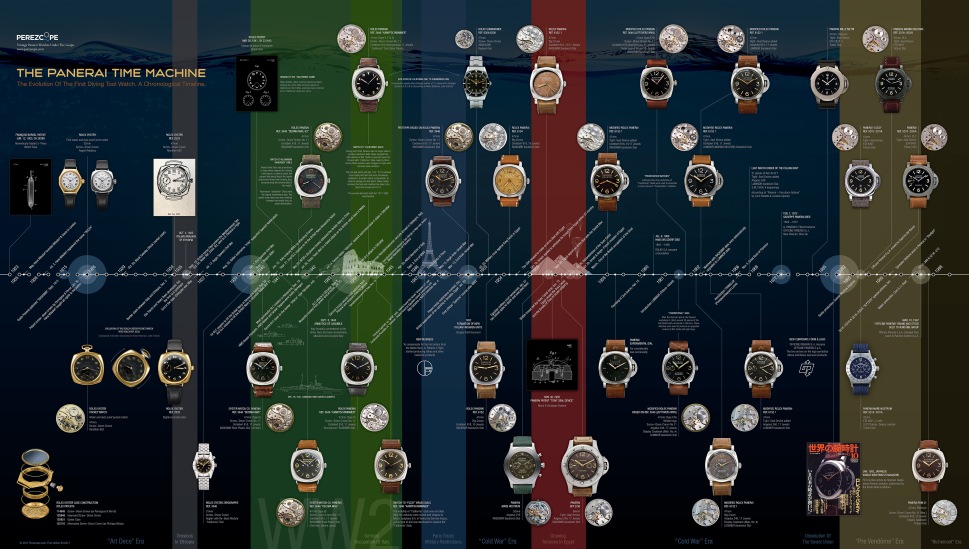
Good day, just as war history and panerai lover want to put some points to this great article.
As I know, Junio Valerio Borghese became commanding officer of the X.MAS on 1. May 1943 so weeks before Italian capitulation and the forming of MSI. Before was as correctly indicated just Sicre submarine CO
In 1944-1945 X.MAS fought against Slovenian partisan forces (sorry comunism is a political view, legitimate, but my ancestors deserve been called with their names)
Great article keep writing
LikeLike
Hello, do you still have some timelimes available? I would like the number 35
LikeLiked by 1 person
Hi Pierre, the limited edition is sold out. The regular edition is still available. I updated this article accordingly.
LikeLike
Thank you ! A pity I didn’t know this article earlier… I have been contacted by Panerai boutique to get a 721 but I didn’t know about this model, and then I found your very complete article, amazing that you also talk about history as well as watches and movements, etc… so much in details ! Thanks again for this article. By the way, you didn’t mentioned that the 721 (and 720) will be with Plexiglas.
LikeLike
Hello Pierre, pls contact me via email: jose()perezcope()com
LikeLike
It seems, they have changed gold hands with blued on 720
LikeLiked by 1 person